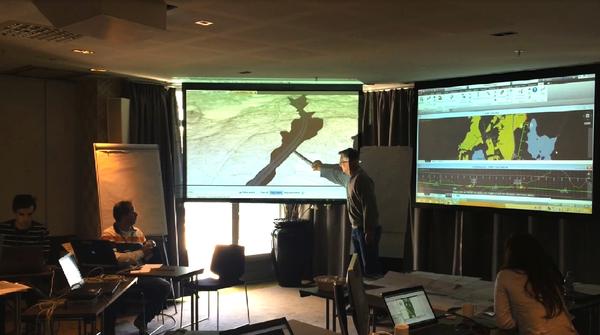Concurrent design of a 20km road: Zoning plan in 2 days!

Can a 7-hour concurrent design stunt of a 20 km long E39 road stretch evolve into a model for future planning of transport infrastructure? The Norwegian road authorities, the “stunt team” of 16 engineers, and Vianova Systems think so…
The special infrastructure test-design was carried out as a 7-hour “stunt” at the opening of this year's Novapoint Users Conference in Haugesund, Norway recently.
“If we could have spent one additional day we probably would have had the zoning plan for the 20 km stretch almost done”, concluded Jan Erik Hoel, Vianova Systems´ project manager and coach during the test project, well supported by the Norwegian Public Roads Administration.

Concurrent engineering
All 16 engineers were placed in a joint project room, where 14 of them designed and shared the road design in a Quadri collaboration model in the cloud. The starting point for the design was just rough sketches of the road alignment, plus ideas on where two 2-level road junctions should be placed.
As basis for the design were laser-scanned data of the landscape corridor, prepared into a terrain model by Scan Survey. The terrain model covered an area of about 240 square kilometres. The road stretch length was about 20 km.
The team worked together for only 7 effective hours. Initially sketching on paper, then using Vianova´s BIM solution Novapoint with the collaboration model solution Quadri
The design engineering was done in three groups – one group working on the road alignment model, the other two working on each of the two junctions.
Findings
All 16 engineers (who notably came from a number of different consulting players in the industry) praised that this was a very effective and fun way of working. The work process was found very meaningful and efficient! Everyone was focused and worked intensively from 10 to 18 only interrupted by a 45 min. lunch. Throughout the work process there was not a single e-mail communicated. All issues were resolved continuously over the table. One of the biggest advantages of this concurrent way of working, was that they got all their questions answered and issues sorted out there and then – including getting onsite support and guidance in using the BIM tools.
Open collaboration is key
“Far from all challenging areas were resolved, but we got a lot of issues on the table”, says project manager Hoel. “Especially useful was a joint review of the road alignment after about five hours of work. The purpose was to uncover areas that required extra processing. We used multiple displays showing the collaboration model in both 3D and longitudinal profile, thus providing a super basis for discussion.”
“We want to help changing the industry views on what is possible to achieve by altering the work methods”, comments Idar Kirkhorn, CEO of Vianova Systems. “We see that concurrent engineering works very well in other industries, so why should it not work well also in the design process of infrastructure? We hope that our little design stunt will help pushing the industry boundaries a little bit further. Novapoint and Quadri are certainly tools that enable such efficient work processes”, says Kirkhorn.
Being a BIM pioneer for infrastructure design for many years Vianova Systems´ annual User Conference is the most important meeting place for this development in the Nordics.